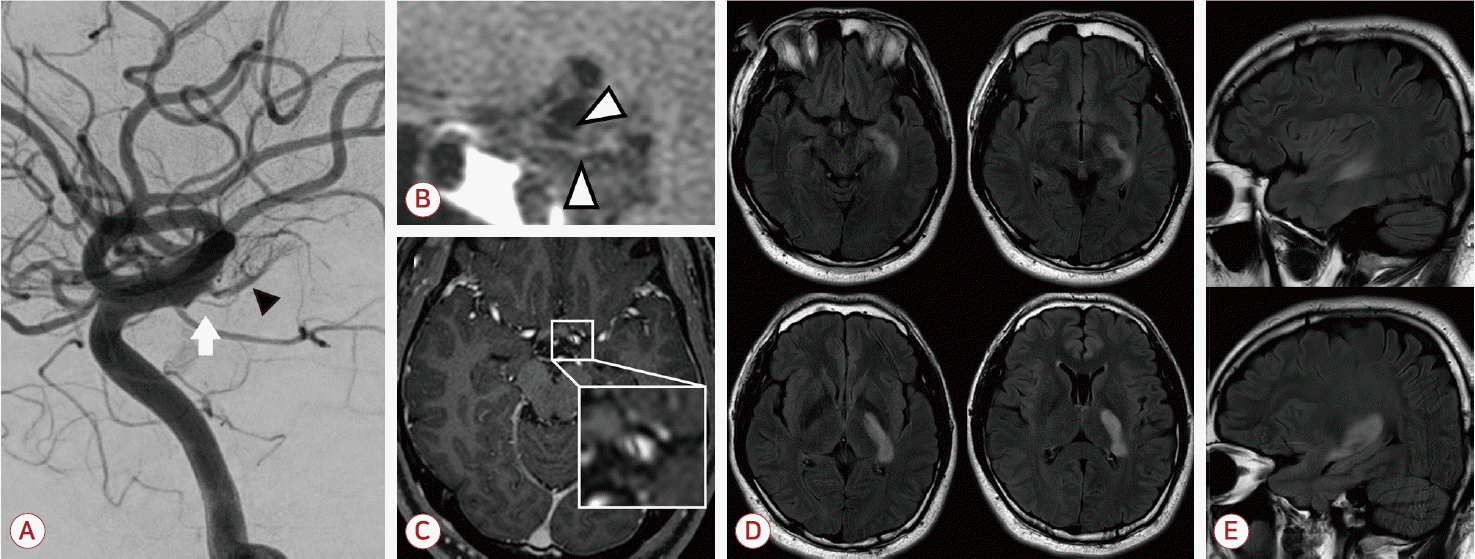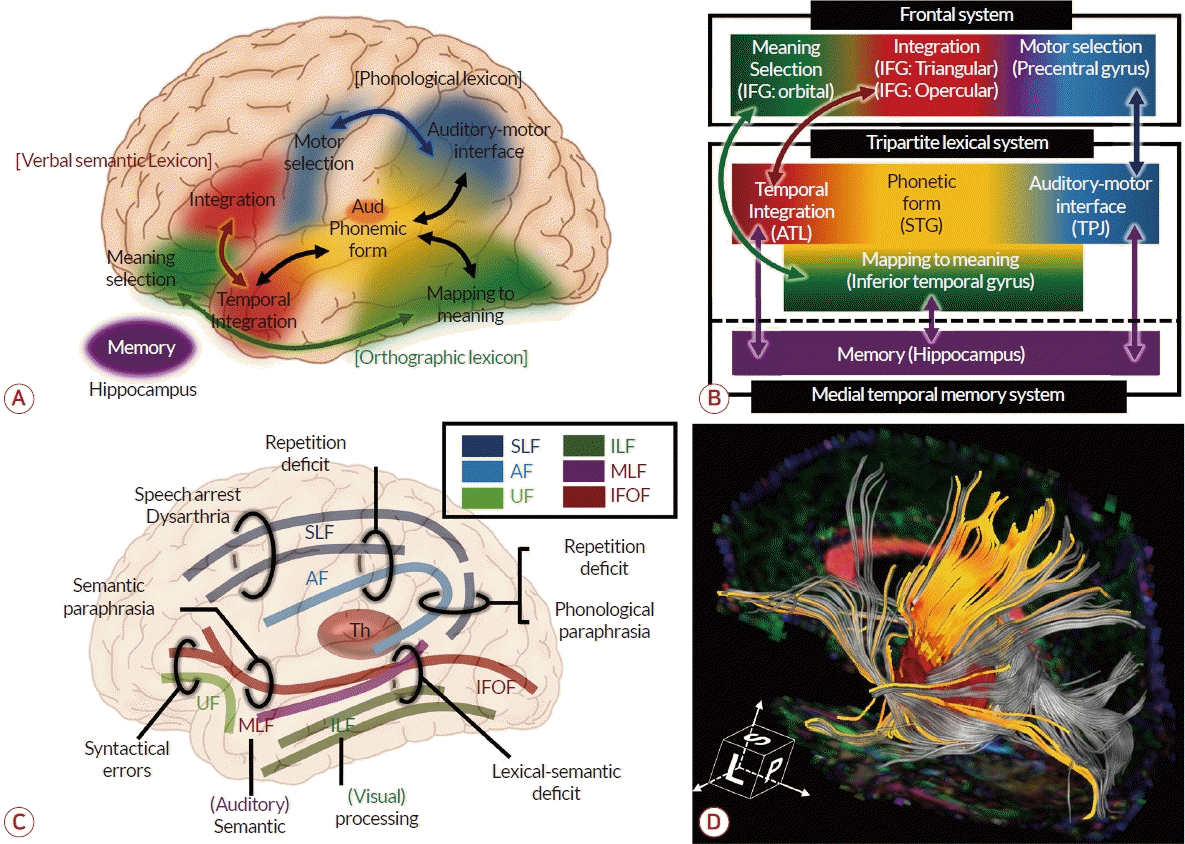의미 체계 손상 없이 어휘-의미 결함을 보인 전맥락막동맥경색 환자: 확산텐서 신경섬유로 분석
Lexical-semantic Deficit without Semantic Impairment in a Patient with Left Anterior Choroidal Artery Infarction: Neural Correlates Based on Diffusion-tensor Tractography
Article information
Trans Abstract
A 35-year-old male presented with atypical aphasia following left anterior choroidal artery infarction associated with distal internal carotid artery dissection. He presented with 1) lexical-semantic deficit without semantic impairment, 2) frequent surface errors (both surface dyslexia and dysgraphia), and 3) intact non-word reading/repetition (preserved sub-lexical route), suggesting deficit in the phonological output lexicon. Diffusion-tensor tractography analysis revealed disruption in the inferior fronto-occipital fasciculus and inferior longitudinal fasciculus, which might serve as potential subcortical neural correlates for phonological output lexicon.
무시증후군, 실어증, 관념실행증 등의 고위 인지기능장애는 일반적으로 대뇌피질을 연루하는 병변에서 발생하지만 드물게 기저핵이나 시상, 백질 병변만으로도 피질성 징후(cortical sign)가 나타나기도 한다. 언어중추가 위치한 대뇌피질 병변 없이 선조-내포, 시상 등의 피질하 병변만으로도 실어증이 유발될 수 있으며, 이를 피질하실어증으로 명명한다. 전맥락막동맥경색(anterior choroidal artery infarction) 병변의 경우 비우성반구에서는 무시증후군을, 우성반구에서는 실어증을 나타내는 증례들이 보고된 바 있다[1]. 우성반구의 전맥락막동맥경색에 의한 실어증은 고전적인 분류 체계에 속하지 않는 비특이적 양상을 보인다[1-3]. 기존 연구에서 명칭실어증과 초피질성운동실어증 양상의 언어장애가 보고된 바 있으나 체계화된 분석은 찾아보기 어렵다[1-3]. 저자들은 좌측 속목동맥박리에 의한 전맥락막동맥경색 환자에서 의미 체계 손상 없이 어휘-의미 결함(lexical-semantic deficit) 및 표층 오류(surface error)를 보이는 비특이적 언어장애 증례를 경험하여 이를 보고한다.
증 례
특이 과거력, 외상력, 흡연력이 없는 35세 오른손잡이 남자가 내원 49분 전 길을 걷던 중 갑자기 발생한 우측 위약감을 주소로 내원하였다. 환자의 교육년수는 14년이었다. 환자는 내원 당시 구음장애, 우측 안면마비, 상하지 위약감 및 감각 저하로 NIH 뇌졸중 척도(National Insitute of Health stroke scale, NIHSS) 10점을 보였다. 뇌 혈관조영컴퓨터단층촬영에서 출혈 소견이 관찰되지 않아 혈전용해제가 투여되었고, 뇌동맥폐색이나 뇌혈류영상에서 이상 소견이 확인되지 않아 혈관 내 재개통 시술은 고려되지 않았다. 혈전용해제 투약 30분까지는 우측 위약감이 호전되다가 45분 이후 초기 신경학적인 악화(early neurological deterioration)가 발생하여 우측 위약감 악화, 좌측 동측수평부채꼴시야결손(homonymous quadruple sectoranopia) 및 실어증이 발생하였다(NIHSS 18점). 증상 발생 21시간 이후 촬영한 자기공명영상(magnetic resonance imaging, MRI)에서 좌측 전방해마, 좌측 속섬유막후지에 급성 뇌경색 소견이 확인되었고, 조영증강 T1-weighted MRI 영상에서 내경동맥박리 시사 소견이 확인되었다(Fig. 1). 정확한 진단을 위하여 시행한 고해상도 혈관벽 자기공영영상(high-resolution vessel wall MRI)에서 전맥락막동맥의 근위부에 목동맥내막판(dissection flap)과 혈관벽 조영증강 소견이 확인되었고, 진단적 동맥 내 뇌혈관조영술에서 속목동맥박리 소견이 확인되어 환자는 원위부속목동맥박리에 의한 전맥락막동맥경색이 확진되었다.

Anterior choroidal artery (AChA) infarction associated with distal internal carotid artery dissection. Dissection of supraclinoid segment of the left internal carotid artery (arrow) involving the orifice of anterior choroidal artery (arrowhead) is shown in cerebral angiography (A). Luminal irregularity and dissection flap-like lesion is shown in high-resolution vessel wall imaging (arrowheads) (B) and contrast- enhanced T1-weighted magnetic resonance image (square) (C). Ischemic lesion in the internal capsule (without involving the genu of the internal capsule), anterior hippocampus (D), and posterior portion of the superior temporal region (E) is shown in the fluid-attenuated inversion recovery sequence.
환자는 알아듣기, 따라 말하기, 발화에는 이상이 없으나 명칭실어증(anomic aphasia)을 보였다. 본인이 표현하고자하는 핵심 단어를 찾지 못하여 유창성이 유지됨에도 불구하고 의미 전달이 잘 되지 않았고, 표현하고자 하는 단어를 설명하기 위해 잦은 돌려 말하기(circumlocution)가 두드러졌다(Appendix 1). 대면 이름대기(confrontation naming) 과제에서 적합한 단어를 답하는 데에는 어려움이 있었으나 특정 물건의 용도 및 의미를 정확하게 설명할 수 있어 의미 체계의 손상을 보이지는 않는 어휘-의미 결함이 관찰되었다. ‘볼펜’, ‘안경’, ‘시계’ 등 일상생활 노출이 잦은 단어는 대답하는 데 시간은 소요되더라도 이름대기에 문제가 없었던 반면, ‘청진기’, ‘주사기’와 같은 일상생활 노출이 적은 사물은 의미 설명은 가능하지만 이름대기는 할 수 없었다.
발병 7일 후 시행한 보스톤 이름대기 검사(Korean version of Boston naming test)에서는 60개 단어 중 46개를 정반응하였다(<0.01%ile). 오류가 있었던 14개 문항에 있어 사물의 의미는 전부 설명이 가능하였으나 이름대기장애를 보였고(예: ‘목발’ → 다리 아픈 사람들이 사용하는 것, 어깨에 끼고 팔 힘을 이용해 걷는다), ‘흙손’ 항목을 제외하고는 음소적인 힌트를 주었을 때 전부 맞힐 수 있었다(Appendix 2). 6개 항목에서 의미착어증을 보였고, coordinate semantic paraphasia (‘고추’ → 오이), associated semantic paraphasia (‘태극기’ → 대한민국) 및 part-whole semantic paraphasia (‘손’ → 손금, ‘뗏목’ → 통나무) 오류 유형을 보였다. 음소착어증은 관찰되지 않았다. 동일 시기에 받아쓰기 과제 역시 시행되었으나 우측 위약감으로 인하여 왼손으로 글씨를 썼다. 환자는 ‘고구마’, ‘감자’와 같은 규칙 단어와 ‘동도나’, ‘피국’ 등의 비단어를 받아쓰는 데에는 어려움이 없었으나 불규칙 단어에서는 표층실서증(surface dysgraphia)을 보였고 (예: ‘값어치’ → 가버치) 추가적으로 영단어 받아쓰기에서도 명확한 표층실서증이 확인되었다(Fig. 2-B, Appendix 3). 읽기 과제에서 규칙화 오류를 보였고, 영단어를 소리 내어 읽게 하였을 때 명확한 표층실독증(surface dyslexia) 소견을 보였으나 비단어를 읽는 경우 이상 소견은 관찰되지 않았다(Fig. 2-C, Appendix 4).

(A) Lexcial and sub-lexical route for reading/writing based on dual-route hypothetical model for dyslexia and dysgraphia is presented. The patient exhibited with surface dysgraphia (B) and surface dyslexia (C), but he did not reveal reading/writing deficit for nonwords. (D) Characteristics of language dysfunction observed in our case are suggestive of anomic aphasia associated with phonological output lexicon deficit.
발병 2주째 한국판 웨스턴실어증 검사(Korean version Western Aphasia Battery, K-WAB)를 실시하였고, 스스로 말하기 17/20 (88.1%ile), 알아듣기 190/200 (95.1%ile), 따라 말하기 92/100 (81.9%ile), 이름대기 69/100 (67.2%ile), 읽기 91/100 (95.7%ile)의 수행을 보여 실어증 지수(K-WAB aphasia quotient) 85.2 (87.2%ile)의 수행을 보였다(Appendix 5). 단 환자는 우측 위약감(grade III)으로 쓰기, 동작 검사 및 구성, 시공간, 계산 과제는 시행하지 못하였다.
환자의 언어장애 양상의 신경기제(neural correlate)를 확인하고자 3D Slicer 4.8.1 4 을 이용하여 뇌경색 부위를 지나가는 섬유에 대한 diffusion tensor imaging (DTI) tractography 분석을 시행하였고, 5 inferior fronto-occipital fasciculus 및 상부 inferior longitudinal fasciulus에서 fractional anisotropy (FA) 저하 소견이 관찰되었다(Fig. 3).

Language circuit involving the tripartite lexical system. Although the patient did not reveal any cortical lesions associated with semantic and lexical processing (A), he presented with lexical-semantic deficit, suggesting disruption in the white matter connecting the cortical hubs (B, C). (D) Diffusion tensor tractography analysis shows the white matter disruptions (orange) caused by the lesion in the anterior choroidal artery territory (red). Fibers that cross the lesion but without decreased fractional anisotropy are presented in gray. Disruptions in the IFOF and superior portion of ILF were observed. IFG; inferior frontal gyrus, ATL; anterior temporal lobe, STG; superior temporal gyrus, TPJ; temporoparietal junction, SLF; superior longitudinal fasciculus, ILF; inferior longitudinal fasciculus, AF; arcuate fasciculus, MLF; middle longitudinal fasciculus, UF; uncinate fasciculus, IFOF; inferior fronto-occipital fasciculus, Th; thalamus.
고 찰
이름대기에는 시각적, 청각적 정보가 의미 체계(semantic system)를 거쳐 그 의미와 연결되어 있는 어휘 체계(lexical system) 및 그 어휘의 음운 정보를 외부로 표현하는 음운 출력 체계(phonological output system)가 관여하며, 해당 경로에 이상 소견이 있다면 명칭실어증(anomic aphasia)이 발생할 수 있다. 명칭실어증의 경우 시청각적으로 입력된 정보가 의미 체계에 도달하는 어휘 체계로부터 의미 체계로의 접근 경로(lexical-to-semantic access)에 문제가 발생하는 경우 혹은 의미 체계에서 어휘 체계로 접근 경로(semantic-to-lexical access)에 문제가 발생하는 경우로 분류할 수 있다(Fig. 2-A).[6] 본 증례의 경우 단어의 의미와 용도의 파악에는 문제가 없었기에, 즉 lexical-to-semantic access 기능은 보존되어 있었기에 후자인 semantic-to-lexical access 즉 의미 체계에서 어휘 체계로 접근 경로에 손상이 있는 것으로 판단할 수 있으며, 이는 나아가 음운출력어휘집(phonological output lexicon) 혹은 음운출력완충기(phonological output buffer)의 손상으로 분류된다(Fig. 2-D). 음운출력어휘집과 음운출력완충기 손상은 하위 어휘 경로(sublexical route)의 결함 여부를 통해 감별할 수 있는데 환자의 경우 비단어 읽기와 따라 말하기에는 문제가 없었기에 음운출력완충기에는 결함이 없고, 음운출력어휘집에 국한된 손상으로 판단할 수 있다(Appendix 4). 더불어 환자에서 관찰된 표층 오류와 음소적 단서에 의한 이름대기 수행 향상 역시 음운출력 어휘집에 국한된 손상을 시사하는 소견이다( Appendix 2-4).
음운출력어휘집 결함에 따른 실어증은 어휘-음운 명칭실어증(lexical-phonological anomia)으로도 명명하는데, 이 경우 정보가 어휘 체계를 거쳐 의미 체계에 도달하는 경로(lexical-to-semantic access)에는 문제가 없기에 단어나 사물(혹은 그림)을 이해하는 데에는 문제가 없고, 비단어 읽기 및 따라 말하기 장애가 관찰되지 않는다[6]. 단, 목표 단어를 음운의 형태로 표상화하는 과정에서 적합한 음운출력어휘집을 활성화시키지 못하면서 음소착어증을 보이거나 의미적으로 연관된 단어의 표상이 대신 활성화되면서 의미착어증을 같이 보이는 경우가 많다. 더불어 의미를 어휘로 출력하는 과정에서 기존의 입력된 음운출력어휘집을 통해 출력하는 어휘 경로(lexical route)를 제대로 활용하지 못하고 하위 어휘 경로(sublexical route)를 활용하기 때문에 그 과정에서 표층 오류를 보이는 경우도 흔하다(Fig. 2). 음운출력어휘집 결함에 따른 명칭실어증의 신경 기제는 보고된 사례가 적으나 우성반구의 하부 두정소엽(inferior parietal lobule)이나 후방 측두엽(posterior temporal)의 피질 병변이 해당 증상을 유발할 수 있는 것으로 알려져 있으며(Fig. 3-A, B) [7-9], 환자와 같이 백색질의 병터만으로 증상이 발생한 증례는 보고된 바가 없다. 본 증례에서 환자의 병변이 DTI tractography에서 inferior fronto-occipital fasciculus 및 inferior longitudinal fasciculus 경로를 침범하는 것으로 미루어 짐작할 때 해당 백색질 다발(fasciculus)이 의미 체계가 보존된 어휘-의미 결함을 특징으로 하는 피질하실어증의 신경 기제에 관여하는 것으로 유추할 수 있다(Fig. 3-D). 해당 병터 연구는 부재하지만 기존의 난독증 연구에 따르면 의미 체계를 담당하는 전측두엽과 음운어휘집(phonological lexicon) 혹은 철자어휘집(orthographic lexicon)으로의 연결 경로에 해당하는 inferior fronto-occipital fasciculus 및 inferior longitudinal fasciulus 등의 손상이 semantic-lexical deficit을 유발할 수 있다(Fig. 3-C) [10].
본 증례의 한계점은 환자의 병변이 전방해마 역시 침범하기에 tripartite lexical system과 내측두엽 기억 체계 연결로의 손상 가능성을 배제할 수 없어 온전히 언어와 연관된 백색질 병터만으로 환자의 lexical-semantic deficit이 발생한 것인지 감별이 불가능하다는 점이다(Fig. 3-B). 더불어 전맥락막동맥 영역은 좁은 부위에 다양한 백색질 다발이 지나가는 부위이기에 병터의 크기나 침범 부위에 따라 다양한 언어장애를 보일 수 있다. 따라서 본 증례의 언어장애 양상을 모든 전맥락막동맥경색 환자의 증상으로 일반화할 수는 없다[1-3].
그럼에도 불구하고 저자들은 다음의 사유로 본 증례가 보고할 가치가 있다고 판단하였다. 첫째, 전맥락막동맥경색은 좁은 영역에 다양한 백색질 다발(fasciculus)이 통과하여 고전적 영상만으로는 신경 기제를 평가하는 데 한계가 있으나 본 연구에서는 확산텐서영상 분석을 통해 병변에 의해 영향을 받은 다양한 백색질 다발을 평가할 수 있었다. 둘째, 한글의 특성상 표층 오류 평가에 제한이 있으나 본 증례의 환자는 비교적 젊은 나이에 뇌경색이 발생하여 한국어와 영어를 모두 익혀 다양한 언어 평가가 가능하였다. 전맥락막동맥경색 환자들이 고전적인 실어증 분류 체계로 설명되지 않는 비전형적 언어장애를 보이는 사례가 보고된 적은 있으나 해당 언어장애 양상을 체계적으로 분석한 보고는 적고, 더욱이 국내 보고는 부재한 상태이다. 따라서 본 증례에서의 언어장애 양상에 대한 예시(Appendix 1-4)는 피질하 병변에 따른 lexical-semantic deficit에 대한 이해도를 높일 수 있는 중요한 보고로 판단된다.



